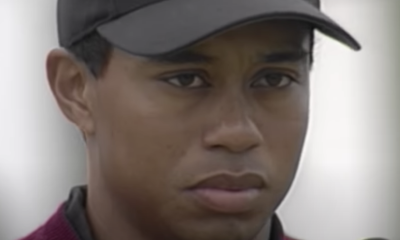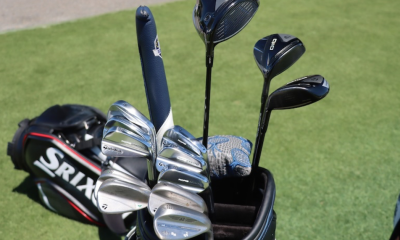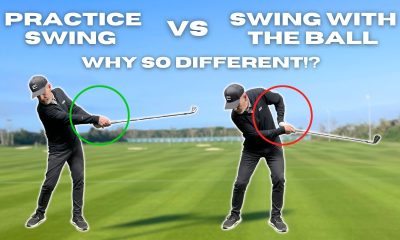Instruction
Clement: Laid-off or perfect fade? Across-the-line or perfect draw?

Some call the image on the left laid off, but if you are hitting a fade, this could be a perfect backswing for it! Same for across the line for a draw! Stop racking your brain with perceived mistakes and simply match backswing to shot shape!
- LIKE0
- LEGIT0
- WOW0
- LOL0
- IDHT0
- FLOP0
- OB0
- SHANK1
Instruction
The Wedge Guy: The easiest-to-learn golf basic

My golf learning began with this simple fact – if you don’t have a fundamentally sound hold on the golf club, it is practically impossible for your body to execute a fundamentally sound golf swing. I’m still a big believer that the golf swing is much easier to execute if you begin with the proper hold on the club.
As you might imagine, I come into contact with hundreds of golfers of all skill levels. And it is very rare to see a good player with a bad hold on the golf club. There are some exceptions, for sure, but they are very few and very far between, and they typically have beat so many balls with their poor grip that they’ve found a way to work around it.
The reality of biophysics is that the body moves only in certain ways – and the particulars of the way you hold the golf club can totally prevent a sound swing motion that allows the club to release properly through the impact zone. The wonderful thing is that anyone can learn how to put a fundamentally sound hold on the golf club, and you can practice it anywhere your hands are not otherwise engaged, like watching TV or just sitting and relaxing.
Whether you prefer an overlap, interlock or full-finger (not baseball!) grip on the club, the same fundamentals apply. Here are the major grip faults I see most often, in the order of the frequency:
Mis-aligned hands
By this I mean that the palms of the two hands are not parallel to each other. Too many golfers have a weak left hand and strong right, or vice versa. The easiest way to learn how to hold the club with your palms aligned properly is to grip a plain wooden ruler or yardstick. It forces the hands to align properly and shows you how that feels. If you grip and re-grip a yardstick several times, then grip a club, you’ll see that the learning curve is almost immediate.
The position of the grip in the upper/left hand
I also observe many golfers who have the butt of the grip too far into the heel pad of the upper hand (the left hand for right-handed players). It’s amazing how much easier it is to release the club through the ball if even 1/4-1/2″ of the butt is beyond the left heel pad. Try this yourself to see what I mean. Swing the club freely with just your left hand and notice the difference in its release from when you hold it at the end of the grip, versus gripping down even a half inch.
To help you really understand how this works, go to the range and hit shots with your five-iron gripped down a full inch to make the club the same length as your seven-iron. You will probably see an amazing shot shape difference, and likely not see as much distance loss as you would expect.
Too much lower (right) hand on the club
It seems like almost all golfers of 8-10 handicap or higher have the club too far into the palm of the lower hand, because that feels “good” if you are trying to control the path of the clubhead to the ball. But the golf swing is not an effort to hit at the ball – it is a swing of the club. The proper hold on the club has the grip underneath the pad at the base of the fingers. This will likely feel “weak” to you — like you cannot control the club like that. EXACTLY. You should not be trying to control the club with your lower/master hand.
Gripping too tightly
Nearly all golfers hold the club too tightly, which tenses up the forearms and prevents a proper release of the club through impact. In order for the club to move back and through properly, you must feel that the club is controlled by the last three fingers of the upper hand, and the middle two fingers of the lower hand. If you engage your thumbs and forefingers in “holding” the club, the result will almost always be a grip that is too tight. Try this for yourself. Hold the club in your upper hand only, and squeeze firmly with just the last three fingers, with the forefinger and thumb off the club entirely. You have good control, but your forearms are not tense. Then begin to squeeze down with your thumb and forefinger and observe the tensing of the entire forearm. This is the way we are made, so the key to preventing tenseness in the arms is to hold the club very lightly with the “pinchers” — the thumbs and forefingers.
So, those are what I believe are the four fundamentals of a good grip. Anyone can learn them in their home or office very quickly. There is no easier way to improve your ball striking consistency and add distance than giving more attention to the way you hold the golf club.
More from the Wedge Guy
- The Wedge Guy: Golf mastery begins with your wedge game
- The Wedge Guy: Why golf is 20 times harder than brain surgery
- The Wedge Guy: Musings on the golf ball rollback
- LIKE88
- LEGIT15
- WOW6
- LOL1
- IDHT0
- FLOP4
- OB1
- SHANK8
Instruction
Clement: Stop ripping off your swing with this drill!

Not the dreaded headcover under the armpit drill! As if your body is defective and can’t function by itself! Have you seen how incredible the human machine is with all the incredible feats of agility all kinds of athletes are accomplishing? You think your body is so defective (the good Lord is laughing his head off at you) that it needs a headcover tucked under the armpit so you can swing like T-Rex?
- LIKE0
- LEGIT3
- WOW2
- LOL0
- IDHT0
- FLOP0
- OB0
- SHANK2
-

 19th Hole2 weeks ago
19th Hole2 weeks agoJustin Thomas on the equipment choice of Scottie Scheffler that he thinks is ‘weird’
-

 19th Hole2 weeks ago
19th Hole2 weeks ago‘Absolutely crazy’ – Major champ lays into Patrick Cantlay over his decision on final hole of RBC Heritage
-

 19th Hole3 weeks ago
19th Hole3 weeks agoBrandel Chamblee has ‘no doubt’ who started the McIlroy/LIV rumor and why
-

 19th Hole2 weeks ago
19th Hole2 weeks agoLET pro gives detailed financial breakdown of first week on tour…and the net result may shock you
-

 19th Hole6 days ago
19th Hole6 days agoGary Player claims this is what ‘completely ruined’ Tiger Woods’ career
-

 Whats in the Bag1 week ago
Whats in the Bag1 week agoTeam McIlowry (Rory McIlroy, Shane Lowry) winning WITBs: 2024 Zurich Classic
-

 19th Hole3 weeks ago
19th Hole3 weeks agoTaylorMade signs 15-year-old AJGA Rolex Junior Player of the Year to an NIL contract
-

 19th Hole1 week ago
19th Hole1 week agoLIV star splits with swing coach after working together for 14 years











Arturo GONZALEZ
Mar 8, 2019 at 3:21 pm
I have been playing golf for ten years. I have heard many times to hit from the inside, and this is the first time I understand how it is done. Previously I had no clue. Today I played nine holes and my game has changed, especially with driver and woods. Thank you so much. The thing that really made me understand was the image of that stick at a 45 degree angle, and making sure the club is parallel to it in the downswing.
geo
Mar 6, 2019 at 8:00 pm
Ive been taught that when club is parallel with the ground in DS (P6)
Shoulders should still be closed to target line, and butt of club pointing at the inside quadrant of the ball.
From that P6 position we can use our torso turning to square the clubface.(face slightly closed to path for a draw and slightly open topath for fade)
If club is parallel to target line at P6, there is nothing left but flip the hands.
Bob Dignan
Mar 6, 2019 at 1:01 pm
This is not new to me, but it is still helpful. Like many long time golfers, I can usually hit a draw when I want to, and often when I don’t. I really have more of a problem with the latter. On the other hand, when I really need to hit a draw, I will often end up with a straight push into trouble. Also, if I try for a draw off the tee, I will often end up with a pull or pull/hook. I get the need to approach the ball from the inside. My problem is getting the club face position relative to the path exactly right, which is what is needed. Still, it is good to see this demonstrated. Another common error for me is to hit a low “smother” shot when trying for a draw. Again, the club face gets too closed relative to the path and buries the ball into the turf. A hard shot for me is a high draw off the tee. I can seldom pull this off. If I manage a draw, it is usually low, or at least not high. In order to fight this I set up with my right shoulder low and try to swing up and out with the club face open to the target line and slightly closed to the path. When I watch your video, it looks like you are working mostly with your left arm swing, which is often my approach. Should I be trying to get the club inside by turning my hips rather than dropping my arms?
Shallowface
Mar 5, 2019 at 6:55 pm
What has worked for me is practicing the old John Jacobs tip of placing a sprig of grass a couple of inches behind the ball and trying to hit that. It is very effective in creating a shallower strike from the inside. As a student of this game for over 45 years, I began to wonder why so many people seem to “get it wrong” in very similar ways. Perhaps it is a perception issue. The effort to hit the ball as opposed to imagining one is coming in slightly behind the ball is what leads to steep slice prone swings.
geohogan
Mar 8, 2019 at 4:21 pm
@shallow face.. totally agree
Its all about intention
How do we hit, anything? with our hands, make a fist and hit.
When we use a broom do we hit, to move a crumb on the floor?
Of course not. We sweep…a shallow , level move across the floor
with our whole body, not just our hands.
Golfers need to take ‘hit’ out of their vocabulary, and instead, ‘sweep’
Ref. The Hogan Manual of Human Performance: GOLF, 1992
geohogan
Mar 5, 2019 at 5:44 pm
IMO a fade is done exactly the same, simply align the body to the left
and have clubface slightly open at impact. ie open to the path.
Isnt that how Ben Hogan and Jack Nicklaus, faded the ball?
Aligh left of target, clubface open relative to the pat at impact, still impacting the inside quadrant of the ball.